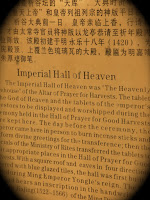I ate a non-traditional Chinese meal tonight: McDonalds. I napped for a while this afternoon and missed eating with the other Missouri travelers, so I took a pilgrimage to the Golden Arches!

I walked over to Ronald's place alone and spent a lot of time watching all the people around me (and there are a LOT of people). I try to walk on the sidewalks, but sometimes end up passing in the street (I highly suggest looking for oncoming traffic). The best way to describe drivers and walkers is to put it into the context of "chicken," the game where someone "wins" by tempting fate the longest.

Ted filmed me narrating traffic the other day, and if you watch the video you may be able to see what we've all experience the past few days in taxis and buses, or as pedestrians. The driver with the boldest maneuver wins!
We're usually carted around the city in a huge 60-passenger bus, so you'd think we ruled our lane, right?? Wrong! We have cars merging on all sides of the bus, forcing the bus driver to force his way into the path of other vehicles. I know this may sound dangerous, but the driving situation on major highways is surprisingly civilized. The majority of China's drivers don't speed, so if it's 100 kph, they're actually going 1oo. When our bus wants to pull off the road onto the exit, we simply merge into the lane next to us, cars in our way either move a little faster, or don't. In my taxi last night, the driver honked his horn, then started barreling towards oncoming traffic-- not for the faint of heart! We pulled back into our lane--had we not, we would've
been the lane, because a dump truck was about to barrel over us! It doesn't matter who (or what) is coming towards you, passing is passing and the strong willed will usually prevail.
Walking in Beijing is quite similar. I'm 6'1" and have a good
height advantage over a lot of the Beijingers I've seen, but that doesn't give me
any advantage in walking the streets of this city. When I approach a slow walker, or couple of walkers, I instinctively jet into the bicycle lane to pass. Unfortunately, there's usually someone coming in the opposite direct, and there is no "right of way" per se, so they (or I) will have to move. Who will move first? I tend to be stubborn, and don't want to walk into the traffic lanes--so I hope the the other pedestrian will move-- which is a 50/50 gamble! I'm courteous to older walkers, or those that are carrying packages, but everyone else is free game. Tonight, I won "chicken" twice and lost once---so that gives me a 66% average for the day. Not bad, but could be worse!
And a quick mathematical thought-- imagine the interstate in your city filled with the usual amount of buses, cars and taxis. Now double or triple that volume. Then add a side lane for bikes, rickshaws and motorized bikes and the odd pedestrian like me. Now, you have Beijing!
Good night!
Mark
P.S. I have to apologize, I'm not blogging as much as I'd like. Blogger is frustratingly unreliable over here in China... blogs rarely go up without a "Connection Reset" screen, especially if it includes pictures! :)
 Today we traveled to the Great Wall of China, and it was incredible! Upon arrival, we found out that Mexico’s President, Felipe Calderon Hinojosa, was visiting as well. We had to wait outside the wall, packed like sardines, for about an hour. For a while, I didn’t think we were going to make it inside. However, once the crowd started moving, it was like a current of human bodies pushing me inside! Once we made it actually onto the Great Wall, it was unbelievable! The stairs were so steep. I was very impressed at the numerous couples who appeared to be in their 80s, making their way to the top of the Wall. However, coming down was a steep slope. I actually slipped and fell, along with two other Mizzou students. It was pretty funny!
Today we traveled to the Great Wall of China, and it was incredible! Upon arrival, we found out that Mexico’s President, Felipe Calderon Hinojosa, was visiting as well. We had to wait outside the wall, packed like sardines, for about an hour. For a while, I didn’t think we were going to make it inside. However, once the crowd started moving, it was like a current of human bodies pushing me inside! Once we made it actually onto the Great Wall, it was unbelievable! The stairs were so steep. I was very impressed at the numerous couples who appeared to be in their 80s, making their way to the top of the Wall. However, coming down was a steep slope. I actually slipped and fell, along with two other Mizzou students. It was pretty funny!


































